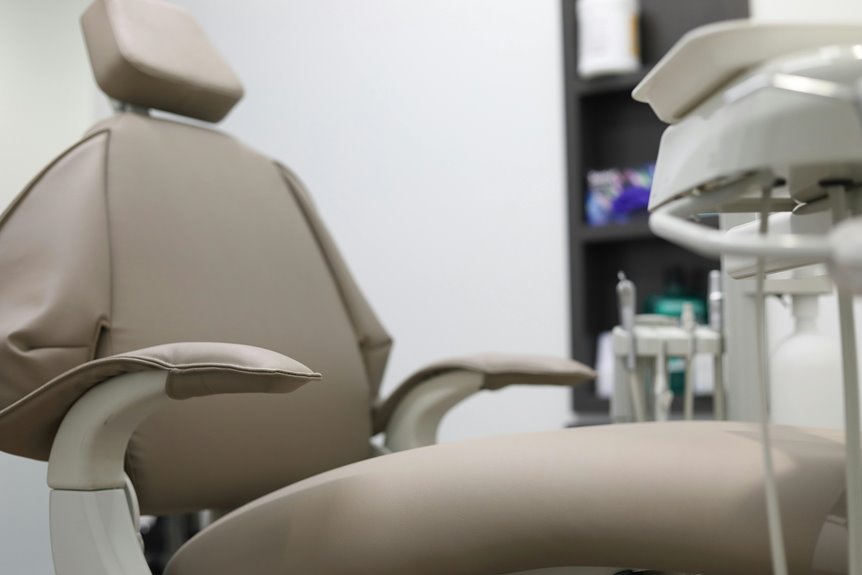When you first sit in your new ergonomic chair, you might notice some discomfort as your body adjusts to its unique support features. It's normal to feel a bit stiff or sore in areas like your back and hips. Understanding what to expect during this breaking-in period can help ease the transition. Let's explore the common challenges you might face and how to make this adjustment smoother.
Table of Contents
Key Takeaways
- Expect initial discomfort as your body adjusts to the new ergonomic design and natural alignment support.
- Soreness in your back or hips may occur during the breaking-in period.
- It's essential to fine-tune seat height and lumbar support for optimal comfort.
- Be prepared for stiffness and restlessness as you adapt to the chair.
- Gradually increase your sitting time and take regular breaks to ease the transition.
Understanding the Ergonomic Design
When you sit in an ergonomic chair, you're embracing a design crafted to support your body's natural alignment. This chair promotes good posture by encouraging your spine to maintain its natural curve.
You'll notice features like adjustable seat height and lumbar support, which cater to your specific needs. The armrests are positioned to reduce strain on your shoulders, and the seat depth ensures your thighs are well-supported without pressure behind your knees.
As you adjust these elements, you optimize comfort and productivity, minimizing fatigue. This design isn't just about comfort; it's about enhancing your overall well-being during long hours of sitting.
Understanding these aspects helps you appreciate how an ergonomic chair can transform your workspace experience.
Common Challenges During the Breaking-In Period
Even with a well-designed ergonomic chair, you might face some challenges during the breaking-in period.
Initially, you may experience discomfort as your body adjusts to the new support. This can include soreness in your back or hips, particularly if you're not used to sitting with proper posture.
You might also find that certain adjustments, like seat height or lumbar support, require fine-tuning to match your preferences.
Additionally, your chair may feel stiff at first, making it difficult to shift positions.
It's common to feel restless or fidgety as you adapt to this new seating arrangement.
Recognizing these challenges is the first step toward a more comfortable experience as you embrace the benefits of your ergonomic chair.
Tips for a Smooth Transition
To ensure a smooth transition to your new ergonomic chair, start by gradually increasing your sitting time. This helps your body adapt without overwhelming discomfort.
Here are some tips to make the process easier:
- Set a timer: Begin with short sessions, like 20-30 minutes, and increase as you feel comfortable.
- Take breaks: Stand up and stretch every hour to relieve tension and promote circulation.
- Stay mindful: Pay attention to how your body feels; adjust your position if you notice discomfort.
- Incorporate movement: Engage in light exercises or stretching throughout your day to maintain flexibility and reduce stiffness.
Adjusting Settings for Optimal Comfort
Adjusting the settings on your ergonomic chair is crucial for achieving optimal comfort and support.
Start by adjusting the seat height so your feet rest flat on the floor, keeping your knees at a 90-degree angle.
Next, position the backrest to support your lower back, ensuring it's set at a comfortable angle.
Don't forget to adjust the armrests; they should support your arms without causing your shoulders to hunch.
If your chair has lumbar support, customize it to fit the curve of your spine.
Finally, take time to test different settings throughout your workday, making small adjustments as needed.
Finding the right balance will enhance your comfort and help maintain focus during long hours of sitting.
Recognizing Signs of Improvement
Once you've fine-tuned your chair settings, it's time to pay attention to how your body responds.
You should start noticing some signs of improvement that indicate your new ergonomic chair is working for you. Here are a few key signs to look out for:
- Reduced discomfort in your back and neck
- Increased focus and productivity during work hours
- Less frequent need to shift positions or take breaks
- Improved posture when sitting for extended periods
If you observe these changes, it's a good sign your chair is enhancing your comfort and well-being.
Maintaining Your Ergonomic Chair for Longevity
To keep your ergonomic chair in top shape, you'll want to establish a regular cleaning routine.
It's also a good idea to adjust the settings periodically to ensure optimal comfort and support.
Don't forget to inspect for any damage, so you can address issues before they worsen.
Regular Cleaning Routine
While you might be tempted to overlook the cleaning of your ergonomic chair, establishing a regular cleaning routine is essential for maintaining its longevity and performance.
Dust, spills, and daily wear can accumulate, affecting both appearance and function. Here's how to keep your chair in top shape:
- Wipe down surfaces weekly with a damp cloth to remove dust and grime.
- Use upholstery cleaner on fabric parts every month to tackle stains and odors.
- Check and tighten screws regularly to ensure stability and comfort.
- Rotate cushions if applicable, to promote even wear.
Adjusting Settings Periodically
As you settle into your new ergonomic chair, adjusting its settings periodically is crucial for ensuring optimal comfort and support. Your body changes throughout the day, and so should your chair. Regular adjustments can alleviate discomfort and promote better posture.
| Time of Day | Adjustment Tips | Benefits |
|---|---|---|
| Morning | Raise seat height | Kickstart your productivity |
| Midday | Tilt backrest slightly | Relieve lower back pressure |
| Afternoon | Adjust armrests | Reduce shoulder strain |
| Late Afternoon | Change lumbar support | Enhance spinal alignment |
| Evening | Lower seat height | Relax after a long day |
Inspecting for Damage
Regular inspections are essential for maintaining your ergonomic chair's longevity and ensuring it remains a supportive ally in your workspace.
By checking for damage regularly, you can address issues before they worsen.
Here's what to look for during your inspection:
- Worn-out upholstery: Check for rips, tears, or fraying that can affect comfort.
- Loose screws and bolts: Ensure all components are securely fastened to prevent wobbling.
- Hydraulic issues: Test the height adjustment feature to see if it operates smoothly.
- Caster condition: Inspect the wheels for any signs of wear or obstruction that could hinder mobility.
Frequently Asked Questions
How Long Does It Typically Take to Break in an Ergonomic Chair?
It usually takes a couple of weeks to break in an ergonomic chair. You'll gradually adjust to its support and comfort, finding the perfect fit for your body as you use it regularly.
Can I Use My Old Chair During the Breaking-In Period?
Yes, you can use your old chair while breaking in your new one. It'll help ease the transition and let you adjust gradually. Just remember to pay attention to comfort as you switch between them.
Are There Specific Exercises to Help With Adjustment?
Yes, there are specific exercises to help with adjustment. Try gentle stretches, shoulder rolls, and back twists. These movements can ease tension and enhance comfort, making your transition smoother and more enjoyable in your new chair.
Is It Normal to Feel Discomfort Initially?
Yes, it's normal to feel discomfort initially. Your body needs time to adjust to new support and positioning. Give it a few days, and you'll likely find the discomfort decreases as you adapt.
What Materials Are Commonly Used in Ergonomic Chair Construction?
Ergonomic chairs often use materials like high-density foam, mesh, and breathable fabrics for comfort and support. You'll also find steel frames and adjustable components, ensuring durability and flexibility to fit your needs perfectly.




